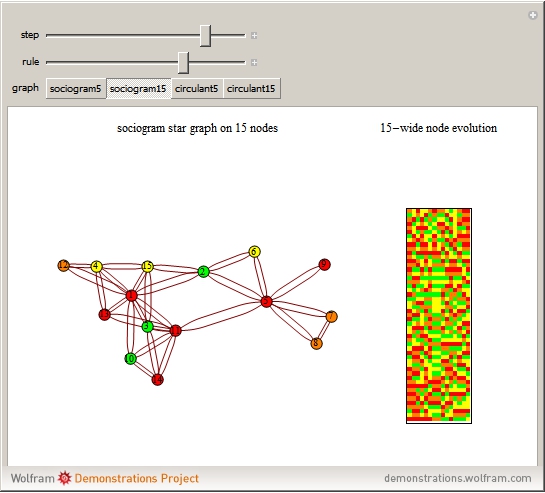Alumni

Bio
An employee of Wolfram Research, Inc. for nearly a year, Abby Nussey is also a singer (coloratura soprano), writer (fiction, poetry, and non-fiction), and all-around thinker. She runs The NKS Blog, a public message board, and a dusty, spider-webbed website for polymaths.
Project: Outer Median Cellular Automata–1D, 2D, and on Graphs
Models of social behavior attempt to illustrate how the various connections between individuals–personal, business-related, political, and so forth–affect or change certain traits of the individuals themselves. In order to model a system where the changing traits of individuals alter other individuals in their various circles, one must find a meaningful way to incorporate the traits of an individual’s neighbors into the determination of the traits of an individual.
Modeling social behavior on grids is one way to get a sense for how traits can be transferred from place to place, with groups occupying certain places feeling the effects of the change. However, there are limitations to this kind of model: the great stage we occupy is not a crystalline lattice, but rather is irregular, with some positions having more or less influence than others. Hence, it makes the most sense to model social behavior on network graphs, where individuals are nodes connected to other nodes.
In this project I look at a functional form of cellular automaton rules in one dimension, two dimensions, and on two different network topologies.
Outer median CAs are constructed by taking a neighbor range specification, finding the median of the color states of the neighbors within the neighbor range specification, and then using a flooring function to translate the median into a relevant color state. The two colors–the active cell and the median of the neighbors–are then used to determine the next color state of the active cell.
These same rules on networks are very similar, with the exception that the neighbors of a node are the nodes directly connected to that particular node.
One-dimensional and two-dimensional evolutions of outer median CAs were explored for this project, in addition to outer median rules on networks. State transition diagrams were generated for both outer median CAs and outer median networks.
Project-Related Demonstrations
Four-Color Outer Median Cellular Automata in 1D
Four-Color Outer Median Cellular Automata on Graphs
Four-Color Outer Median Cellular Automata on the Grid
Favorite Radius 3/2 Rule
Rule 322



